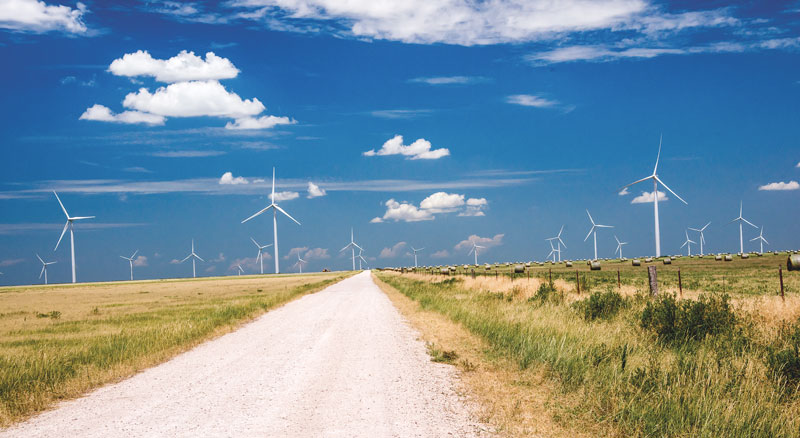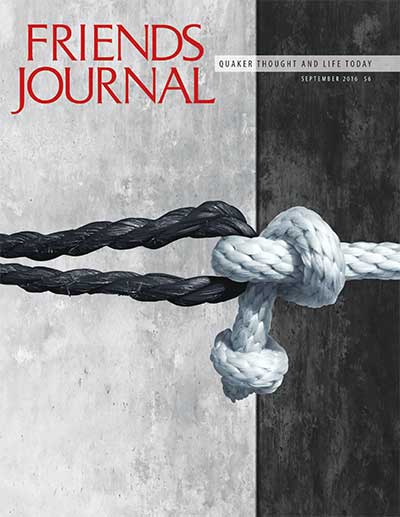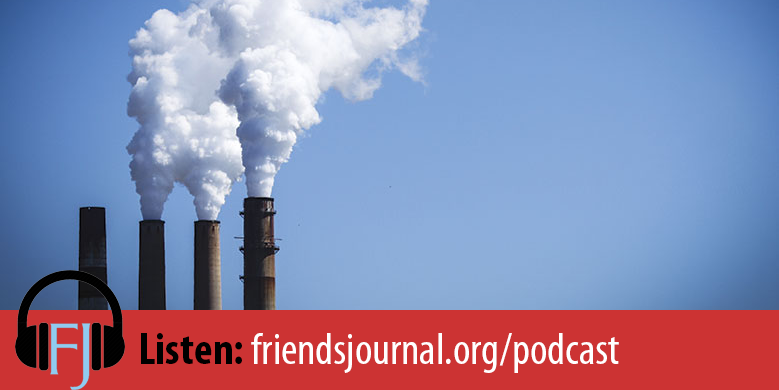
FJ PODCAST SUBSCRIPTION: ITUNES | DOWNLOAD | RSS | STITCHER
I don’t want to talk about climate change, and you probably don’t want to hear about it either. Honestly, it is just too big of a problem. So how does a Quaker meeting respond constructively to such an urgent issue without getting lost in fear or despair? Normal feelings and Quaker values can both get meetings motivated and keep them stuck. This is a story about feeling impelled to address climate change by walking the rocky path toward divesting from fossil fuels. It also tells how one monthly meeting—Community Friends Meeting in Cincinnati, Ohio—and its earthcare committee continued to give energy for divesting to our quarterly and yearly meetings.
Our monthly meeting’s earthcare committee first began talking about divestment in 2012. Divestment from fossil fuels is intended to raise global awareness of the current climate crisis, similar to how divestment from South Africa raised world awareness of Apartheid. Discussion around the topic often slipped into disagreements, and by 2013 earthcare meetings were stressful. What some committee members saw as constructive if intense discussion, others experienced as unacceptable, sometimes disrespectful conflict. Two committee members had already quit because of the discord. The struggle centered around integrity and lifestyle change. Some people felt strongly that to divest with integrity, everyone would have to make many significant lifestyle changes. Turning down the thermostat was what I dreaded most. Committee members felt both obligated and unable to make other lifestyle changes if we divested. One committee member sincerely believed that divesting our trust fund from fossil fuels would obligate us to advocate for nuclear power. Some committee members saw divesting as losing a place at the table, meaning the right as shareholders to advocate at fossil fuel corporations’ stockholder meetings. There were enough touchy topics to exasperate us all. For four months our earthcare committee did not even meet.
Perhaps this fruitless arguing left us all unmotivated. Working with numbers, particularly money, made me uneasy, but I decided to learn more as an attempt to become an effective new clerk of the committee. Divestment, I soon discovered, was a movement to raise world awareness about the dangers of extracting and burning 80 percent of known reserves worldwide in coal, petroleum, and natural gas. Along with other gases, carbon dioxide from burning these fossil fuels forms a transparent shield that traps heat in our atmosphere. This greenhouse effect is the primary cause of global warming, also called climate change. It is an unintended and surprisingly rapid result of the Industrial Revolution, begun only 250 years ago—a blink in time, compared to the nearly 800,000 years since our ancestors first used fire.
Other ecology issues like population are equally important but more difficult to resolve. However, the immediate worldwide problems created by global warming could be addressed with existing technology. Food security and living space are directly tied to global warming. We already have the understanding and technology for sustainable clean power and water conservation, but lack one key ingredient: political cooperation to implement sustainable power quickly and worldwide.
Discussing other social action topics seems easier than talking about climate change. If you said that problems for women were heating up in Nicaragua, a likely reply would be, “I didn’t know. Tell me about it.” There would be immediate shared understanding: these are facts. But if you say that global problems with climate are heating up, a likely reply is, “Well, in my opinion . . .” or even, “I don’t want to hear what the UN scientists say.” Someone with a graduate degree said that one. Maybe the facts about climate are so hard to face that people want to dismiss them as opinions. It made me frustrated that members of my own meeting did not want to listen. They were annoyed because I wouldn’t stop talking. The funny thing is I feel the same way sometimes and intentionally put climate change out of my own mind. In other words we silently shared a wish: Stop talking to me about those facts.
Climate change really is tough to discuss, and ironically Friends’ generally helpful values of patience, valued silence, and equality can make it more difficult. Most social action issues seem distinct from each other. Friends assume each issue has merit, just as each individual’s emotions and opinions are treated with equal respect. If a monthly meeting wants to act on a social concern, we take time to season differences, then reach consensus. Sometimes it takes years, but we patiently trust the process. Climate change is different because of mounting scientific evidence that it will affect everyone and interact with so many other problems like migration and food security. The Intergovernmental Panel on Climate Change asserts that we must act promptly to avert increasing irreversible global climate disasters. Once these severe climate changes begin, they say it will be too late to reverse them. These terrible facts and predictions impose a strong sense of urgency.
A gentle and highly respected Friend explained that when we all felt peaceful unity about divesting, that would be the right time. In earthcare committee we could not imagine feeling peaceful about climate. Everything I could understand said the right time for action is now. I struggled with how these feelings of terrible urgency drove me to encourage everyone to make climate change a higher priority than other meeting concerns. Gone were the times when we could take turns attending to various issues; climate should come first. But placing one issue higher than other priorities seems incompatible with Friends’ equality testimony. No other issue had ever demanded rapid action and yet been so difficult to talk about and actively address.

Would divestment be financially practical for Community Friends Meeting? Our meeting’s small trust fund is held in mutual funds. I phoned every socially responsible mutual fund’s office, asked questions, and reviewed their written information. Some well-rated, low-risk, fully divested mutual funds turned up. From the end of 2013 to early 2014, four existing socially responsible divested funds were joined by three more. That made a total of seven mutual funds that had the kind of social screens Friends meetings would require. Long- and short-term rates of return showed several funds consistently made money. With these facts, I was transformed from uneasy skeptic to excited divestment advocate. Divesting is a financially reasonable response to scientifically proven facts about the climate crisis. Divesting is an action that would speak truth to power, in a language corporations understand: money. Divesting is both witness and concrete action. Divesting from fossil fuels seemed like a quick, simple step, so the earthcare committee worked to approve a monthly meeting minute before yearly meeting that summer. Our arguments subsided, but there was no shared enthusiasm, and we had trouble composing a minute to bring to business meeting.
Out of respect, I was holding back my feelings most of the time, trying to reason with people. It was exhausting. I felt afraid, and sensed those who quietly implied or privately expressed their opposition to divesting and work on climate change were also afraid. It is possible that a vicious cycle was occurring. The more resistance someone might openly express about environmentally motivated actions, the more divestment advocates wanted to offer them persuasive information. Instead of bringing people into discussion then agreement, those upsetting facts seemed to discourage people from talking about climate at all. The less they discussed it, the less terrible facts they had to hear. Climate change advocacy felt like being a green sheep.
What a relief it would have been to be able to ignore climate change issues! But as time went on the popular media carried more and more articles on the changing environment. Even switching off the weather reports of record-breaking temperatures and destructive storms, I could not avoid what was outside my window or in the park nearby. A wind storm stronger than anything I had ever seen sheared off the top 30 feet of the pine tree in our yard. A local wooded trail became dusty during a spring drought. This is the midwest—we don’t have spring droughts. Well, we didn’t until now.
Feeling unable to ignore climate change, I tried to move each step toward divestment as quickly as possible. When earthcare committee had not completed a divestment minute, stewardship committee was willing to bring a minute forward for discussion. But the presiding clerk felt it needed to come from earthcare committee. I wrote another divestment minute. The presiding clerk was satisfied, but earthcare members wanted changes. At a called meeting of earthcare committee, with the presiding clerk’s guidance, we came to unity on a minute. I networked, made phone calls (some never answered), and prepared several information sheets (some of which it seemed nobody read). Whatever I could think of, I did it. I was told this was not the way Friends acted, but I couldn’t see how or why to stop. I was the most vocal divestment advocate, but without the committee’s continued work, and the support of others in the meeting, nothing would have happened.
The presiding clerk announced a threshing session and a work group to prepare for it, including someone who seemed very opposed to divestment. Including opposing views was the right thing to do but really hard. The work group disagreed about what to include in a background information statement. Someone insisted we delete explanations about mutual funds. A generally wise Quaker said we must not mention fear and greed when talking about investments, even though financial advisors named these emotions as the most common causes of bad financial decisions. Not wanting to provoke arguing like we had earlier in earthcare committee meetings, I stood aside and inwardly simmered. Sometimes I wished we could just vote and get it over with. Divesting seemed to be a simple, sensible action, a small step. Why was this so hard?
At the well-attended threshing session, about 20 people spoke out of the silence, all in favor of divestment. Afterward the monthly meeting treasurer privately asked me, “Could we lose money from divesting?” Why did such an important question go unasked during threshing? The answer was in the mutual fund information that had been deleted from the background information pages. People I knew to have reservations did not express them during the actively worshipful threshing session, but I wondered if they would object to the divestment minute when it came up in business meeting. If the business meeting had as much discord as earthcare committee and some private conversations indicated, a divestment minute might never be approved.
Two Friendly inclinations were likely to collide during meeting for worship with attention to business when we sought approval for the divestment minute. We have at least one member who is drawn to the intellectual stimulation of argument, and at least one more likely to be feisty. Quite a few other people have heartfelt desires to avoid conflict. Would arguments increase stress for the conflict-averse people, causing legitimate difficulty with discernment? If that happened, the divestment minute would be set aside for seasoning or sent back for wordsmithing, dragging out the process, possibly drifting indefinitely into oblivion. The day before our June 2014 business meeting, to work off tension, I was swimming laps of backstroke. A faint rectangle of pastel stripes appeared in the blue sky. Was it an arc of rainbow? There had been no rain. A rainbow was God’s promise to Noah never to cause another environmental disaster. That small arc of rainbow felt like a good sign.
The next day, Community Friends Meeting peacefully approved divestment, and became the first monthly Quaker meeting west of Philadelphia to approve a divestment minute. It happened just a few weeks before Ohio Valley Yearly Meeting (OVYM)’s 2014 summer sessions. After seeing our information table at yearly meeting that August, Miami Meeting in Waynesville, Ohio, divested in October. At next February’s quarterly meeting in 2015, Community Friends’s earthcare committee put on a workshop about divesting. To lighten up after presenting grim facts about climate, we had a skit. Sarah Scattergood, overwhelmed by ecological lifestyle changes, meets Letitia, the Light with a big gold Q on her t-shirt. They agree that everyone can make changes one step at a time. The laughter from the skit and a game show-type quiz, “Who Has Divested?”, helped break the tension discussing divestment always seems to create. I also wrote and told a story: Quinn the Quaker environmentalist has a professional ecology job in town. Quinn drives a small pick-up truck 40 miles to work from the family’s organic farm. The old gas-guzzling pickup is needed for farm work, and Quinn can’t afford a hybrid car or an apartment near the job. The point being that even a professional environmentalist like Quinn cannot be expected to make instant lifestyle changes.
During discussion after the presentations, the co-clerk of our Miami Quarter criticized divestment as a token gesture. Only lifestyle change would make the crucial differences, she said. Suddenly, put on the spot, I felt open to that truth. Divestment is just a quick, simple thing to do while planning what really matters.
At the next quarterly meeting in April 2015, a divestment minute was on the agenda. “Simple, small, and practical” was the theme of our short information sheet. We also distributed descriptions of socially responsible divested mutual funds, the same material that had been deleted for our monthly meeting’s threshing session. When the presiding clerk called for discussion of the divestment minute, there was none. Then a few dreary voices said, “Approve.” Divestment seemed to have become just another thing on a chore list.
Our other quarterly meeting co-clerk forwarded the minute to yearly meeting. By that time, divestment had somehow again morphed into a significant decision. The usual process with important actions was to present a minute one year and approve it during the following yearly meeting. I felt strongly that we do not have that kind of time.
Our monthly meeting earthcare committee decided to survey all of our yearly meeting’s local groups informally to find out if we had a chance of approving a divestment minute during the same yearly meeting when it was brought forward. We phoned and emailed people in all 20 other monthly meetings to discover driving and restraining forces, an old community organizing activity called force-field analysis. Some meetings were interested but cautious. We emailed information whenever requested. Even a meeting with a green retrofitted meetinghouse had penetrating discussion before indicating support of divestment. Several monthly meetings gave no response. Repeated emails and voicemails from two different earthcare committee members were unanswered.

Years ago, I had been oblivious to my meeting’s finances, but was surprised to discover how many Quakers were not aware of their meeting’s investments or socially responsible options. By early summer we estimated 10 of the 21 monthly meetings clearly agreed with divesting, and one would probably stand aside. There were several uncertainties: the yearly meeting treasurer had been ambivalent; another highly respected Friend might stir up conflict by insisting on specific wording; a monthly meeting that had not found unity over other financial matters was not ready to discuss divestment; and the unknown thoughts of eight monthly meetings where no one answered our voicemails and emails. No reason to judge that lack of response—our own earthcare committee used to find climate change a topic too hot to touch. We were prepared to travel to any interested meeting. One monthly meeting with no funds to divest sent a letter of support. Only one person expressed interest in our visiting their meeting. Perhaps there was that assumption that we would take a year between presenting the minute and approving it, as usual.
Then OVYM’s presiding clerk emailed his plan: Present the divestment minute Wednesday, have a threshing session, and—maybe—approve it on Saturday. That timing felt right, but also created pressure.
To keep from feeling too anxious, I focused on giving my personal best to this project, and trying to remember that had to be enough. That meant making a speech before yearly meeting threshing session, preparing many information handouts, and creating a display. We already had a black-and-orange display board on climate change. It was so accurate, informative, and eerie that I could hardly look at it. We needed a positive message about raising world awareness about fossil fuels and the reality of clean sustainable energy alternatives. We needed to offer hopeful facts, reasons for optimism.
Our committee’s environmental scientist had several good examples of success, and one claim that seemed both remarkable and impossible. He said the hole in the ozone is closing. I couldn’t believe it. Manufactured CFCs (chlorofluorocarbons) in refrigerants and aerosol sprays caused the ozone layer of Earth’s atmosphere to thin, then develop a hole. Currently the hole waxes and wanes with the seasons, sometimes growing so big that the moon could fit through it. Without the ozone’s protection, too much ultraviolet light reaches Earth, increasing skin cancer and cataracts, and preventing some plant growth. If human efforts really were making the ozone hole start to close, that would be a huge change. Unsuccessful at finding confirming facts in the public library, I was reduced to googling, “Is the hole in the ozone closing?” An article popped onto the computer screen: hole in the Earth’s ozone layer is finally closing up, according to a recent study by NASA scientists. Most of the nations of the world had signed the United Nations 1987 Montreal Protocol, promising to stop using CFCs. When DuPont Chemical invented a safe alternative to CFCs, all over the world most nations made the change. The resulting improvement in the ozone layer of Earth’s atmosphere came from this global political cooperation plus new technology. I had been so frustrated and busy trying to move divestment forward, that I had not stopped to talk to God. But this news radiated divine presence. God spoke through this healing of the ozone, and I finally listened. Although still scared, I became full of hope and optimism.
Our world solved the ozone problem, so we can solve another atmospheric problem: climate change from burning fossil fuels. Wind and solar are rapidly becoming two sustainable alternative sources of power. At yearly meeting, divestment received a fresh motto: “Divestment, for a Bright and Breezy Future,” referring to solar and wind power. Here was realistic optimism and hope. It filled a new, blue display board, half a dozen information handouts, my three-minute speech, the speeches of an environmentally devoted father and his college-age son, and many affirmations during yearly meeting threshing session on divestment. Optimism and realistic solutions supported our divestment minute. Right after the threshing, the presiding clerk asked, “Do Friends approve this minute?” Spirit-filled hope rang out through many voices, “Approve!” At Ohio Valley Yearly Meeting the summer of 2015, we midwestern Quakers became the third yearly meeting in North America to adopt a divestment minute, a year ahead of Quaker time.
Ohio Valley Yearly Meeting Divestment Minute
Approved July 30, 2015
Ohio Valley Yearly Meeting of the Religious Society of Friends (Quakers) commits to divesting our yearly meeting’s financial resources from all fossil fuel extraction companies. OVYM will publicize this act of divestment from all corporations involved with extracting coal, petroleum, and natural gas as one way to raise awareness of the critical global challenge of climate change. We will make these financial changes to reflect right relationship with Earth, as well as other Quaker values, including equality and integrity. We will do so as soon as reasonably possible. We encourage our members and other Quaker bodies to take similar action.




Comments on Friendsjournal.org may be used in the Forum of the print magazine and may be edited for length and clarity.